‘Next goal the winner’: Village football in Ayrshire, 1947 to 1958
Roy Hay
(Click or double-click on the photographs to enlarge them)
Our family moved to the tiny little village of Straiton, in Carrick, the southern third of the county of Ayrshire in Scotland in 1947. It lies on the fault line dividing the central lowlands from the southern highlands.
My father was the headmaster of the local primary school which had a roll that varied from around fifty to just under a hundred. Numbers could be affected significantly by the arrival or departure of a large family at one of the farms in the area. At times my sister and I and one other boy were the only pupils who lived in the village itself, the rest came from the surrounding countryside. The school seldom, if ever, played football matches against other schools because there were too few pupils at any age group to field an eleven. There were only 5 boys in my class year for most of my primary education.
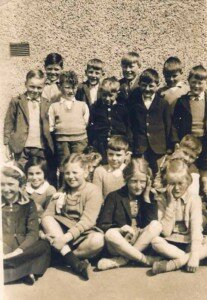
Straiton Primary School. The boys in my class included Ian McWhirter and Peter McMillan (back row, extreme left pair), John McWee and Michael Heaney (second row extreme left). I am on the right in the third row.
The pupils played football on the asphalt area around the school, which had a shed with a roof and two upright supports which provided one goal and a couple of dustbins or a pile of jackets would suffice at the other end. Playground ‘fitba’ rules applied.[i] Games would start before school in the morning and continue through mid-morning, lunch and afternoon breaks. After school and at weekends I would spend hours kicking and heading a ball against a blank wall at the back of the school, one of real perks of living in the schoolhouse.
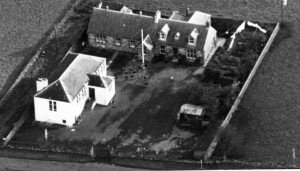
Straiton Primary School. The football playing area is across the foreground. The blank wall of the main school building, the white harled one on the left, faces the other school classrooms, while the school house is on the right beyond the flagpole.
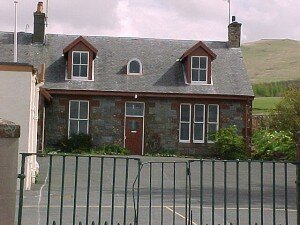
A more recent photograph of the schoolhouse and the playground. The markings for what may be a football pitch or netball/basketball court are a much later addition.
The village never had a formal football team, as far as I know, unlike the slightly larger villages of Crosshill and Kirkmichael which were about four miles away to the west and north respectively. Their teams played in the south Ayrshire amateur leagues. Maybole was larger still, around 4–4,500 people. Maybole Juniors played in the semi-professional lower tier Ayrshire leagues. Junior football in Scotland is not a youth competition, but an open age competition below what is called senior football. Talented young players in the senior ranks are often farmed out to junior clubs to toughen up, while senior players on the way down may spend some seasons in the junior ranks at the end of their careers. It makes for a very physical and competitive environment. It would be somewhat similar to the relationship between the VFA and the VFL in Australian football in the old days. Ayr United and Kilmarnock represented the county of Ayrshire at the professional senior level of Scottish football. None of my generation from the village went on to play football at senior level in Scotland.
Later at secondary school, Carrick Academy in Maybole, we would play before getting on the bus in the morning, before school started, at most playtimes and lunch breaks. Playground fitba rules applied here too. In one notorious period of about eight weeks one or other of our number broke a window of the school during our kickabouts in the playground, but since I was number eight on the list and the headmaster had had enough, I remember being the one who was belted for the misdemeanor. Not only that but the headmaster told my father and I was on the end of another licking when I got home.
No football was played in the winter evenings because it was dark between four and five pm by the time we got home from school. On Saturday mornings some of the older boys from the villages might turn out for their secondary school team, as I did, but that was in Maybole, seven miles away. In the afternoon, those who were interested would travel by bus, bicycle, minibus or rarely by car to Somerset Park in the county town of Ayr to support ‘the Honest Men’ of Ayr United.
In the summer it was very different. Between 5 and 7 pm a small knot of youngsters would be found around one of the goals in the village football field playing with a dilapidated leather ball. The game would probably be ‘three-and-in’ to start with. One lad was in goals, and the rest played as individuals trying to score, and when you got three you swapped with the keeper. Soon the numbers would grow, eventually sides would be picked and jackets might be deposited about the half way line to form a second goal. Gradually the whole field would be brought into use. By 10 pm there might be upwards of 50 players, roughly, very roughly, divided into two halves, though two less competent or younger players might be balanced by a talented or older one.[i] Late arrivals would join in on the same principles.
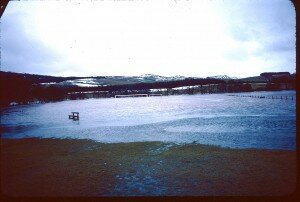
Straiton football field under water during a flood of the River Girvan. It was not usually this wet when we played in summer.
Offside would be variable, there being no referee most of the time, and only the most blatant ‘poaching’ would be sanctioned. If you were goal sneaking (Australian term) or poaching (Scottish term) then your goal would not count, but if you ran through on a pass from deep you would be allowed to proceed as long as there was a defender in the rough vicinity. So that and most other decisions were by rough consensus with a little bit of the Greek principle (might is right) thrown in if things got heated. Positional play and passing was also variable, possession of the ball and dribbling much more common and clumps of players around the ball also.
Free kicks were limited. You were expected to look after yourself and being kicked on the shins or up in the air with a sliding tackle was ‘all part of the game’. Rules changed in the gloaming. As it grew too dark to see, around 11 pm in high summer, the cry would go up, ‘Next goal the winner’ even though the score might be 23-12 at the time, if you happened to have been counting since some point in the past, resulting in a frantic scramble to bring the game to a conclusion.
Very occasionally a professional footballer would turn up as a friend of one of the participants and join in, risking his livelihood in the mayhem of bodies. So Peter Price, Ayr United’s star centre-forward, who later played in Australia scoring a hat-trick in his first game for Gladesville-Ryde against Hakoah in 1963 in the Sydney First Division, also had a kick-about with us in Straiton long before that.[i]
Yet there was one game of football played near the village that received international exposure. It was the centerpiece of one of the most awful films ever made, entitled The Match. Made in 1999 and despite a star cast including Ian Holm, Isla Blair, Richard E. Grant and Neil Morrissey, with cameos by Pierce Brosnan, who invested money in it and was one of the producers, and Alan Shearer, the England and Newcastle United striker, it clunks along as Scottish whimsy gone wrong. The conceit is that the local pub and an upmarket bistro have played an annual football match 99 times with the pub going down each time. Now the 100th iteration is to be the decider (‘next goal the winner’), only the loser is to voluntarily close down. Shot in and around the village, the talented cast make as much as they can from a pretty leaden love and football story. Gregory’s Girl or Local Hero it is not. There is a review in Variety, which does its absolute best to pump up the tyres, but that is a struggle.[i] The locals did not do well out of the film either and I think some of them are still owed money.[ii]
The actual match is not played on the football field in the village but in an expanse of roughly flat land possibly on Genoch farm south of it by about a couple of miles.[i] This is a more photogenic location and quite appropriate in a way since the local farms were loci of a range of sports even in the post-war years. Each farm had its own particular sport—badminton, china or lawn bowls, tennis, even croquet. The farmers and some of the villagers, like the Hays, ‘neighboured’, as it was called. That is they would band together for the labour intensive elements in the annual farming calendar, harvesting, shearing sheep, lifting potatoes and turnips and so on. After the day’s ‘darg’ (work) was done a pig or a sheep might have been killed to provide food for all and in the evening after supper everyone would take part in the farm’s game.
Nevertheless, football was the most central game to the local sporting year, only rivaled by badminton in the village hall over the winter evenings. Football provided a topic of conversation and an ice breaker even for the majority of the population whose only contact with the game might be doing the football pools or listening to a game on the radio. Television was only just reaching the village in the 1960s and reception was very poor. My future wife remembers coming to the school house and seeing the family huddled round a black and white television whose signal came from Northern Ireland at times, only 30 miles away to the south-west.
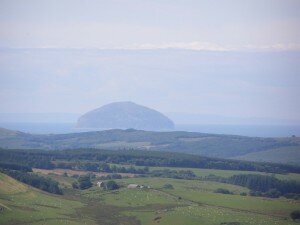
Ailsa Craig with the Antrim Hills in Northern Ireland just visible as a darker line above the horizon. The view is from Craigengower Hill looking to the south-west.
The story was that the BBC and Scottish television shot the football matches ‘using a box brownie with a sock over the lens’, such was the poor quality of the vision. It looked on the screen as if a snowstorm was occurring as the figures fluttered around. The green and pink evening sports papers, the Citizen and the Evening Times, could be picked up in Ayr on a Saturday night, while Sunday Post and daily papers carried pages of match reports and football gossip. None of them ever had anything to say about football in Straiton.
Yet, football was part of the shared culture, not always overt or demonstrative, but always there. International and big club games were always anticipated and picked over in the aftermath. A group of the young men, and a very occasional woman, would organise a trip to Glasgow for an international match or a Cup final. A few older men would be regulars at Somerset Park. My Latin teacher at Carrick Academy for all but the first two years had a fatal flaw—his support for Ayr United. He could be sidetracked into discussions about the game whereas his predecessor taught with a strap to hand to sting the palms of those whose declensions and conjugations left something to be desired.
I doubt if my own family’s involvement in the game had much influence on me at the time. That came much later. My father would very occasionally join in the games in the playground but he did not talk about his own truncated career. He won a Scottish Cup medal as a schoolboy in Ayr, but never played professionally. One of my uncles was for a time the manager of the Masons Arms pub in Maybole and I remember very occasional conversations about his father and pictures of him on the wall. My grandfather’s exploits at club and international level must have been a topic of discussion with members of our extended family and occasional visitors but that had little impact when I was young. As the oldest male of the next generation some of the family memorabilia and news cuttings came to me but I stored them away for the future. It was not till 2004 that I began to put together his story and that came about as I was trying to find a way to help shape my mother-in-law’s autobiography which my wife and I were editing for her 90th birthday.[i] Realising I had this cache of material I thought it might help if I put it to use as a dry run for the other book.[ii]
In my penultimate year at Carrick Academy I applied for and received a place in a program leading to a cadetship in the Royal Air Force. This brought in some money for the household and the prospect that I would be put through university without cost to my parents. In spring 1958 the headmaster of Carrick Academy and I travelled to the RAF College at Cranwell to see what was involved and to encourage him to promote the scheme among future students. As we travelled south by train overnight the news of the Munich disaster, when the plane carrying Manchester United’s team home after a European Cup match crashed on take-off, was just breaking. At each station there would be updates and a scramble for the early editions of the newspapers.
After I left the village for the Royal Air Force later in 1958 I played for RAF Henlow where I was a technical cadet in local competition and against the aircrew cadets at Cranwell.
The following year, after passing out as an Acting Pilot Officer, I went on to Manchester University and played for my hall of residence, but never had the ability or really the inclination to make the professional ranks. Subsequently I played football for Balliol College at Oxford and with mixed amateur staff and student teams at the universities of East Anglia, Glasgow and Deakin University in Australia.
Later still I became a part-time journalist writing about local, national and international football and writing and researching the history of the game in Australia.[i]
I am still unclear why my football trajectory took the form it did. Growing up in south Ayrshire, even in an area that had no claims to football success, it was inconceivable to us that the game we played had not been around since time immemorial and that the Scots had invented and owned it.[ii]
[i] Roy Hay & Bill Murray, A History of Football in Australia: A Game of Two Halves, Hardie Grant, Melbourne, 2014.
[ii] Mining villages on the Ayrshire coalfield like Annbank and Glenbuck produced barrowloads of football stars. Roy Hay, James ‘Dun’ Hay, 1881–1940, pp. 4–6.
[i] Catherine Wells, with the assistance of Roy and Frances Hay, Catherine Wells, an extraordinary ordinary woman, Sports and Editorial Services Australia, Teesdale, Victoria, 2004.
[ii] Roy Hay, James ‘Dun’ Hay, 1881–1940: The Story of a Footballer, SESA, Teesdale, Victoria, 2004.
[i] Bea Holden tells me the game was played somewhere near Loch Lomond, not in the village at all. This is something that needs a bit of research. I wonder if it had something to do with the claim in the review mentioned above that the setting for the film was the highlands?
[i] Derek Elley, review of The Match, Variety, 9 August 1999, http://variety.com/1999/film/reviews/the-match-1200458758/
[ii] So I was told on a later visit to the village, but in case this is libelous let me make it clear it came from a ‘usually reliable source’.
[i] Soccer News (Victoria), 25 April, 1963, p. 5. Peter Price’s career as all-time top scorer with Ayr United (213 goals) is covered in Duncan Carmichael, The Official History of Ayr United Football Club, published by the club, 1992 and his 100 Greats: Ayr United Football Club, Tempus, Stroud, 2004 and in Walking Down the Somerset Road: The Complete History of Ayr United, Fort Publishing, Ayr, 2006.
[i] Jim Cassels, who grew up in North Ayrshire, and Peter Swain, who lived in Bolton, Lancashire, have similar stories. Jim talks about a “cock” and “hen” system to pick later additions to sides. ‘I remember that but also a “cock or a hen” would be used. The arriving pair deciding in advance who was “cock” or “hen” and one of the teams being asked to choose a “cock” or a “hen”.’
[i] One version can be found on the Sports and Editorial Services Australia (SESA) website at: http://www.sesasport.com/?p=2508

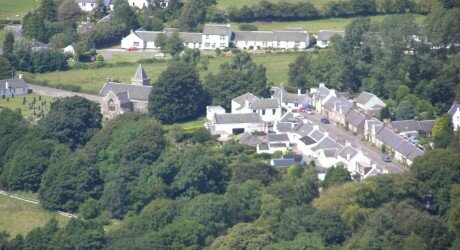
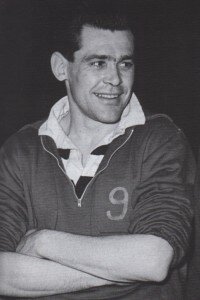

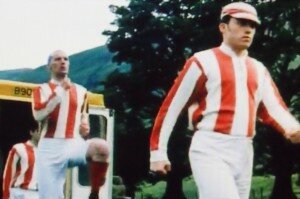
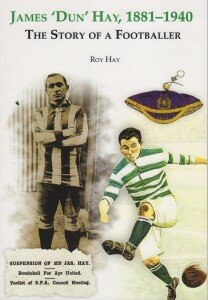
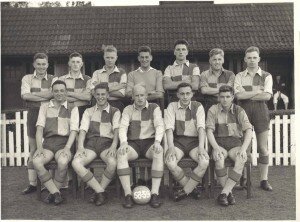






Marnie Haig-Muir: Your review of the latest Rankin is right on the money, Roy. This book...